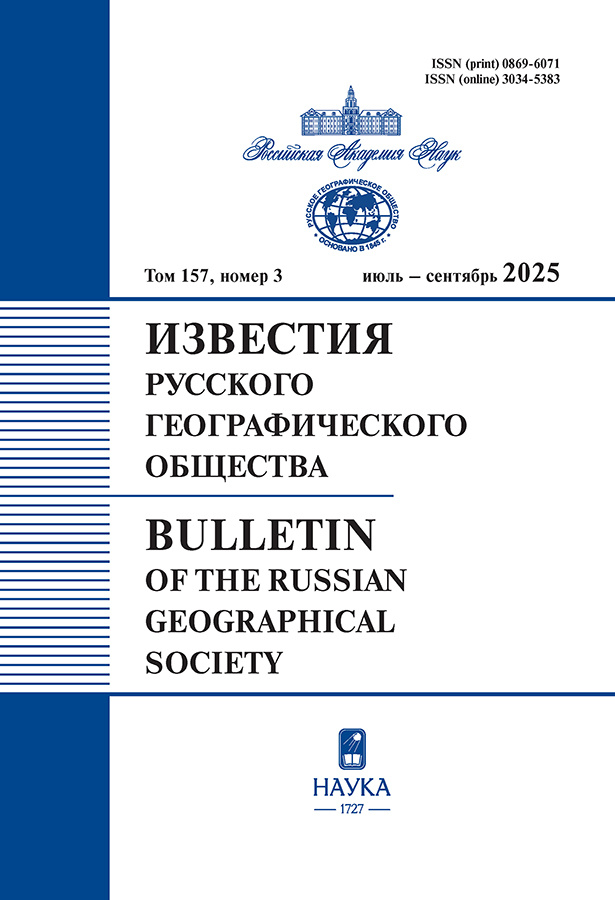Sensitivity of phytoproduction in low-mountain steppe landscapes in the southern Urals to hydrothermal fluctuations
- 作者: Khoroshev A.V.1
-
隶属关系:
- Lomonosov Moscow State University, Faculty of Geography
- 期: 卷 157, 编号 3 (2025)
- 页面: 288-304
- 栏目: Articles
- URL: https://journals.eco-vector.com/0869-6071/article/view/691764
- DOI: https://doi.org/10.31857/S0869607125030034
- EDN: https://elibrary.ru/ltehtv
- ID: 691764
如何引用文章
全文:
详细
Identification of the natural range and sequence of landscape states is required to assess the response of the phytoproduction process to external signals in terms of inertia and susceptibility. We studied the spatio-temoral dynamics of normalized difference vegetation indices (NDVI) in the steppe landscape of the Orenburgsky Reserve to rank groups of natural units by the sensitivity of functioning to hydrothermal fluctuations and climatic trends. Data for the vegetation period of 2013-2024 for 82 periods were taken. We performed the principal component analysis to identify 5 factors describing either the NDVI dynamics for a particular part of the vegetation period or the specific response of units to extreme weather events. Eight classes of annual variation were identified, differing in the time of reaching the peak of phytomass and the severity of its late summer decrease. We found evidence for the synchronicity of intraseasonal changes in average NDVI between groups of units. Various forms of resistance to hydrothermal fluctuations were distinguished. Xeropetrophytic and dry steppes on ridges and slopes are the most resistant to summer drought almost not losing phytomass. However, they are susceptible to heavy precipitation in the late summer and increase phytomass. In case of climate warming and drying, they will be the most resistant. Typical steppes on the plateau on loamy southern chernozems are more susceptible to late summer extreme precipitation, provided that the first half of summer was wet. Xeromesophytic and mesophytic communities in gullies lose phytomass most strongly during summer drought being almost not susceptible to additional moisture. This makes them the most vulnerable in case of increase in temperature and decrease in precipitation.
作者简介
A. Khoroshev
Lomonosov Moscow State University, Faculty of Geography
Email: avkh1970@yandex.ru
Moscow, Russia
参考
- Базилевич Н.И. Биологическая продуктивность экосистем Северной Евразии. Москва: Наука, 1993. 293 с.
- Барталев А.С., Егоров В.А., Жарко В.О., Лупян Е.А., Плотников Д.Е., Хвостиков С.А., Шабанов Н.В. 2016. Спутниковое картографирование растительного покрова России. Москва: ИКИ РАН. 208 с.
- Беручашвили Н.Л. Этология ландшафта и картографирование состояний природной среды. Тбилиси: Изд-во Тбилисского университета, 1989. 198 с.
- Гродзинський М. Д. Ландшафтна екологія. Київ: Знання, 2014. 550 с.
- Коломыц Э.Г. Экспериментальная географическая экология. Записки географа-натуралиста. Москва: Товарищество научных изданий КМК, 2018. 716 с.
- Мордкович В.Г. 2014. Степные экосистемы. Новосибирск: Акад. изд-во “Гео”, 170 с.
- Рябинина Н.О. Степеведение. Волгоград: Изд-во ВолГУ, 2014. 472 с.
- Титлянова А.А., Базилевич Н.И., Шмакова Е.И., Снытко В.А., Дубынина С.С., Магомедова Л.Н., Нефедьева Л.Г., Семенюк Н. В., Тишков А.А., Ти Тран, Хакимзянова Ф.И., Шатохина Н.Г., Кыргыс Ч.О., Самбуу А.Д. Биологическая продуктивность травяных экосистем. Географические закономерности и экологические особенности. Новосибирск: ИПА СО РАН, 2018. 110 с.
- Хорошев А. В. Пространственная структура как фактор стабильности биопродукционного функционирования степных геосистем (на примере Айтуарской степи, Южный Урал) // Принципы экологии. Т. 9. 2020. № 3. С. 71–86.
- Хорошев А.В., Леонова Г.М. Реакции при изменении увлажнения в ландшафте Айтуарской степи (Южный Урал) // Вестник Московского университета, серия 5 география. 2015. № 4. С. 95–103.
- Хорошев А.В., Калмыкова О.Г., Дусаева Г.Х. Оценка индекса NDVI как источника информации о надземной фитомассе в степях // Исследование Земли из космоса. 2023. № 3. С. 27–43. https://doi.org/10.31857/S020596142303003X
- Eastman J.R., Sangermano F., Machado E.A., Rogan J., Anyamba A. Global trends in seasonality of normalized difference vegetation index (NDVI), 1982–2011 // Remote Sensing. Vol. 5. 2013. P. 4799–4818. https://doi.org/10.3390/rs5104799
- Fabricante I., Oesterheld M., Paruelo J.M. Annual and seasonal variation of NDVI explained by current and previous precipitation across Northern Patagonia // Journal of Arid Environments. Vol. 73, Issue 8. 2009. P. 745–753.
- Fedorov N.I., Zharkikh T.L., Mikhailenko O.I., Bakirova R.T., Martynenko V.B. Forecast changes in the productivity of plant communities in the Pre-Urals steppe site of Orenburg state nature reserve (Russia) in extreme drought conditions using NDVI // Nature Conservation Research. Заповедная наука 2019. 4 (Suppl.2). P. 104–110. https://doi.org/10.24189/ncr.2019.044
- Gilmanov T.G., Tieszen L.L., Wylie B.K., Flanagan L.B., Frank A.B., Haferkamp M.R., Meyers T.P., Morgan J.A. Integration of CO2 flux and remotely-sensed data for primary production and ecosystem respiration analyses in the Northern Great Plains: potential for quantitative spatial extrapolation // Global Ecology and Biogeography. 2005. Vol. 14. P. 271–292.
- Hossain L., Li J. NDVI-based vegetation dynamics and its resistance and resilience to different intensities of climatic events // Global Ecology and Conservation. Vol. 30. 2021, e01768. https://doi.org/10.1016/j.gecco.2021.e01768
- Jobbagy E.G., Sala O.E., Paruelo J.M. Patterns and controls of primary production in the Patagonian steppe: a remote sensing approach // Ecology. Vol. 83(2). 2002. P. 307–319.
- Klimavicius L., Rimkus R., Stonevicius E. Seasonality and long-term trends of NDVI values in different land use types in the eastern part of the Baltic Sea basin // Earth system changes in marginal seas / Oceanologia. Vol. 65. 2023. P. 171–181. https://doi.org/10.1016/j.oceano.2022.02.007
- Sternberg T., Tsolmon R., Middleton M., Thomas D. Tracking desertification on the Mongolian steppe through NDVI and field-survey data // International Journal of Digital Earth. Vol. 4(1). 2011. P. 50–64. https://doi.org/10.1080/17538940903506006
- Vogel A., Scherer-Lorenzen M., Weigelt A. Grassland resistance and resilience after drought depends on management intensity and species richness // PLoS One. Vol. 7(5). 2012, e36992. https://doi.org/10.1371/journal.pone.0036992
- Wang R., Gamon J.A., Montgomery R.A., Townsend P.A., Zygielbaum A.I., Bitan K., Tilman D., Cavender-Bares J. Seasonal Variation in the NDVI–Species Richness Relationship in a Prairie Grassland Experiment (Cedar Creek) // Remote Sensing. 2016. Vol. 8, 128. https://doi.org/10.3390/rs8020128
补充文件






